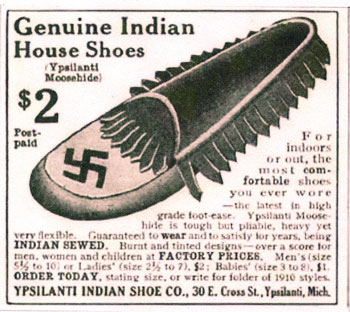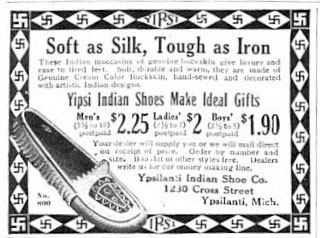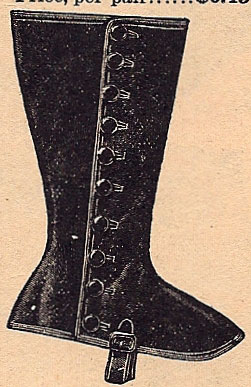In the Archives: Faint Footprints
Swastika slippers made in Ypsilanti were once openly advertised in national magazines – including Collier’s and Cosmopolitan. In its day, the footwear didn’t cause outrage, or taint the city as sympathetic to Nazis – even though two other Ypsi companies made similar items. The fringed footwear pre-dated Hitler’s rise by around 20 years.
The swastika slipper was made in the Indian Shoe Company’s little third-floor factory at 17-21 Cross Street, above the present-day Fantasy Attic costume store. In the high-ceilinged space full of light from large south-facing windows sat an array of shoemaking machines with tough leather-penetrating needles, operated by about a dozen women and a few men.
Benjamin Boyce managed the company, but soon moved on to become the bookkeeper for the Peninsular Paper mill. His lengthy December 12, 1956 Ypsilanti Daily Press obituary makes no mention of his involvement with the Indian Shoe Company.
During Boyce’s tenure there, the company’s 1910 Depot Town neighbors included Charles Dueress’s grocery store, King and Pressler’s second-hand shop, Pearl Laundry, the business office for the underwear factory, C. M. Fairchild & Company’s flour and feed store, coal dealer John Engel’s office, and the Oliver House hotel. The district was bustling and noisy, with frequent trains pulling in and out of the depot area on multiple parallel tracks.
The Indian Shoe Company made moccasins from scratch, starting with cured hides that may have come from the Ypsilanti Hide and Leather Company, John Howland’s odiferous tannery. “The smell coming from that place is intolerable, especially in the evening when there is but a slight breeze,” said the July 14, 1909 Ypsilanti Daily Press, quoting a ‘prominent Forest Avenue matron.’ That matron may have pulled a rawhide string or two – soon after that, Howland moved his tannery from Forest Avenue to 25 South Huron at the south edge of the commercial district.
After delivery to the Indian Shoe Company, the skins were cut into pieces using patterns. Finished sizes ranged from 3 1/2 to 10 for men and 2 1/2 to 7 for women, along with children’s sizes. Many of the moccasins were decorated with designs made with colored ink or a leather-burning tool. The designs incorporated what the company judged to be Native American motifs.
One 1910 model featured the large swastika on the toe. The Indian Shoe Company likely chose this design due to its traditional use as a decorative motif by the Navaho, Hopi, and other indigenous peoples, long before the symbol acquired its indelible association with evil during WWII.
The completed moccasins sold by mail for $2 [$46 in 2010 dollars]. “[T]he most comfortable shoe you ever wore – the latest in high grade foot-ease,” boasted one 1910 ad. The ad claimed that the shoes were made of a material it called “Ypsilanti Moosehide.” “Ypsilanti Moosehide is tough but pliable,” it said, “heavy yet very flexible. Guaranteed to wear and to satisfy for years, being INDIAN SEWED.”
A full-page 1913 ad in the outdoorsman’s publication The Outing Magazine went further, touting the shoes as perfect for a range of outdoor and indoor uses. It was, for instance, an ideal yachting moccasin.
“[F]or canoeing, for tennis, for camp wear, our number 900 shown below is a favorite,” said the ad. “It’s a dandy in the gymnasium, too … [and for] camping, hunting, and cool weather … This same shoe makes a splendid, comfortable, foot-resting house slipper to wear at home in the evening.” By this time the Indian Shoe Company had devised a logo, consisting of the word “YIPSI” in a horizontal diamond – presumably with the extra “I” so that out-of-town customers wouldn’t wonder how to pronounce the strange four-letter word.
Perhaps the strangest aspect of the Indian Shoe Company’s story is that it was one of three moccasin companies in Washtenaw County – none of which operated in the county’s largest city. Around 1910, Ann Arbor had nearly twenty shoemaking shops, including Justice Houghtalin’s shop on Liberty, the Walk-Over Shoe Co. on Main, and Clark & Cooch (“Bang-Up Shoes for Boys”) on both Forest Avenue and South University. All three moccasin manufactories, however, were in Ypsilanti.
In Ypsi in 1906, Sumner Damon founded the Elk Skin Moccasin Manufacturing Company at 11 North Huron. A year later, Thomas McAndrew’s Horner Specialty Shoe Company began making moccasins and athletic shoes. In 1909 the Indian Shoe Company was the last to arrive on Ypsi’s bustling moccasin manufacturing scene.
“During the past few years the ‘Indian fad’ has taken the country almost by storm,” wrote one O. H. Kipps in a 1906 edition of Southern Workman magazine. “There has been a great demand for all sorts of Indian handiwork … Indian purses and moccasins … have been placed upon the market by enterprising dealers.” It may be that the three Ypsi companies were formed to capitalize on this so-called ‘Indian fad.’ However, the demand for such goods eventually faded.
The Indian Shoe Company went out of business just a few years after opening. The Horner Specialty Shoe Company, which for a while shared factory space with the Indian Shoe Company, also closed. For a while in the 1920s before it too went out of business, the Elk Skin company became the third moccasin maker to occupy the Cross Street space – making that space the unrivaled historical hotspot of moccasin manufacturing in all of Washtenaw County.
Now used as apartments, the Depot Town space is all that remains. Aside from an obscure ad or two in forgotten publications and a few listings in city directories, Ypsilanti’s early 20th-century era of locally hand-crafted moccasins vanished leaving no footprint.
Mystery Artifact
Jim Rees and Irene Hieber correctly guessed that last column’s artifact was a potato planter.
Presumably it was invented to save the toil of stooping, hand-digging, and planting, but it seems that using this tool would still be fairly arduous, doesn’t it?
This time we have a mystery artifact that perhaps wouldn’t be found in the potato fields. It’s an odd little device; what might it be?
Good luck!








spats. A word I always enjoyed saying. Over the shoe, around the ankle, protected the lower leg (and trouser) from mud. Dandified ‘boot’ replacement. Now being brought back by a few who use them in women’s wear (steam punk / Victorian redux).
fun stuff!
Spats
When young I was a Socialist
Despite my tender years;
No blessed chance I ever missed
To slam the profiteers.
Yet though a fanatic I was,
And cursed aristocrats,
The Party chucked me out because
I sported Spats.
Aye, though on soap boxes I stood,
And spouted in the parks,
They grizzled that my foot-wear would
Be disavowed my Marx.
Its buttons of a pearly sheen
Bourgois they deemed and thus
They told me; ‘You must choose between
Your spats and us.’
Alas! I loved my gaitered feet
Of smoothly fitting fawn;
They were so snappy and so neat,
A gift from Uncle John
Who had a fortune in the Bank
That one day might be mine:
‘Give up my spats!’ said I, ‘I thank
You–but resign.’
Today when red or pink I see
In stripy pants of state,
I think of how they lost in me
A demon of debate.
I muse as leaders strut about
In frock-coats and high hats . . .
The bloody party chucked me out
Because of Spats.
–Robert William Service
That’s a gaiter. We still use gaiters today, but they look somewhat less form fitting, and are used to keep snow or scree out of your boots. Mine are for x-country skiing and keep the snow out. They’re made of gore-tex… instead of buttons, mine come with velcro fastenings.
Lines On H—’s Foot
It may be you’ve seen her eyes,
Dark and deep like midnight skies;
You mayhap have seen them flash
Underneath the drooping lash,
And been dazzled by the light
Of those orbs, so dark and bright;
But-have you seen her foot,
In its little gaiter boot?
You have noticed, maybe, how
The lily spreads from chin to brow.
You have thought her cheek more fair
Than if roses lingered there;
(Roses would seem out of place
On her pale patrician face)
But-again I question you,
Have you seen her tiny shoe?
You have thought her mouth, no doubt,
Like a blush-rose half blown out;
Small and sweet, withal, beside,
Touched with scorn and curved with pride;
(Innate pride-not meant to chill)-
You have seen it there, and still-
Answer one more question, pray-
Have you seen her boot? I say.
Such a tiny, tiny thing,
Is that foot of which I sing;
No. 3 would hide it so
It could not be found, I know.
No. 2 must stand aside
All too long and large and wide,
No. 1 must be the boot
For this maiden’s little foot.
You may envy, sir, the clerk
In the shoe-store, hard at work,
Who tries the gaiter boot
On this cunning little foot.
On his knee, supporting it,
Saying, ‘It’s a perfect fit,’
Buttoning on the No. 1,
Looking sorry, when it’s done.
You have seen her, slight and neat,
As she tripped along the street,
You have heard the pit-pat-fall
Of that foot so very small.
That she’s fair, and pure, and good,
Bright, and sweet is understood,
But-have you seen that foot-
In its dainty gaiter boot?
–Ella Wheeler Wilcox
Imagine is right, that’s not a spat but a gaiter. The button work and other detailing suggests to me that this particular one was probably as much a matter of fashion as of leg protection.
I notice that the Cosmopolitan ad gives “Yipsi” rather than today’s “Ypsi”. Was the city’s name once pronounced yĭp′·sĭ·lăn′·tē rather than today’s ĭp′·sĭ·lăn′·tē ?
To satisfy your urge to go back in time, call (734) 973-1210 to hear “Welcome to your Meijer Yipsilanti pharmacy.” The voice you hear answers the phone at all Meijer pharmacies with appropriate local identification — even in Kentucky. I’ve called this little booboo to the store’s attention with the response “Oh, really.”
cmadler: “The postoffice, in a period of six months, recorded sixty-four different ways in which the name was spelled, none of them correct; and strangers in the city are commonly identified by their pronunciation of the first syllable as “Y-i-p,” which is not at all the proper pronunciation.”
–Harvey Colburn, “The Story of Ypsilanti,” p. 46.
Colburn of course was a minister, not a historian, and “Story” is a gentle hagiography, not an accurate history. It was published in 1923, and I know there are some older songs/comic poems that play on the pronunciation–those might have additional clues as to possible different older pronunciations. I don’t have any at my fingertips but will take a look to see if I can dig some up.
Poohbah: Tried a call: “WELcome!– to your…YIP-silanti pharmacy!” Too funny! Weird that a Michigan-based company would get that wrong. Though I imagine there are other Michigan communities, maybe with Native American names, that have the same shibboleth effect.
Re:[7] Tried calling as Laura did. And yes, there’s something that strikes me as fairly hilarious about it.
Do they pronounce Meijer as “Meyer” or Major”? Same as putting an “s” on the end of Ford or K-Mart: some sort of accent that has lingered in the area.
When I was in the Linguistics biz, we called that the “Michigan genitive.” It’s a puzzle why some names get it and others don’t. I collected examples for a while. Never heard K-Mart’s, but Kroger’s, Farmer Jack’s, Kellogg’s, Meijer’s and Ford’s were common; Chrysler’s or GM’s, never.
Re:[12] I’m thinking that most of the time, it’s because the companies were named after their founders; e.g., Mr. Ford’s Car Company (which is what I heard occasionally growing up). Chrysler is the obvious exception.
Other usages attested on the internets: Walmart’s (!), Rite-Aid’s, Target’s, Home Depot’s(I have never heard these); (Montgomery) Ward’s, Penney’s, Jewel’s, Panera’s (these I have). I think Dennis Preston at MSU is the go-to guy on this.
So much for that theory!
I recently heard someone referring to the a high school sports state playoffs as “states”, as in “they’ve got the bracket for states out”. Weird. Is that another example of the Michigan genitive?
No, I think that’s just a plural, a condensed version of “state playoffs.” You also hear “districts” and “regionals.”
Rod: that is fascinating about the “Michigan genitive.” I realized I use it too without thinking twice about it. A bit of Googling reveals that this is an apparently common feature of German. Due to my ignorance I hesitate to guess if local German immigrant settlers transferred this linguistic feature to English when they learned/spoke the latter.
Interesting comments on states/regionals, too.
Here is an interesting article that quotes Preston and examines some distinct/amusing features of Michigan English: [link] There’s also a link to a podcast of a discussion of the subject on the Craig Fahle Show.
Excerpt: “Every generation says that language is going to hell in a basket,” Preston says, adding, “For some odd reason, despite this trip to hell, the language survives.”
Fun article! (But, man, it really mangles the description of the NCS, mixing it up with a couple other phenomena).